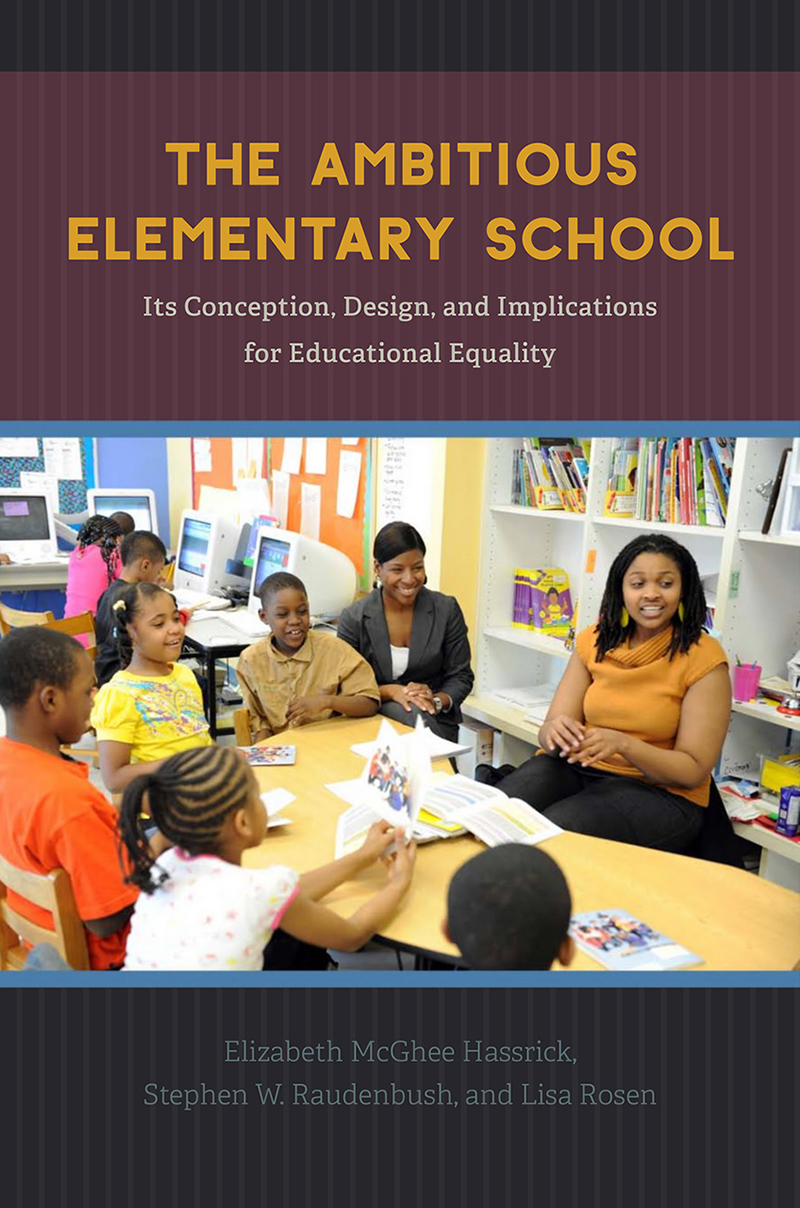 The Ambitious Elementary School: Its Conception, Design, and Implications for Educational Equality
The Ambitious Elementary School: Its Conception, Design, and Implications for Educational Equality
by Elizabeth McGhee Hassrick, Stephen W. Raudenbush, and Lisa Rosen
University of Chicago Press, 2017, $25.00, 240 pages
As reviewed by Daniel Hamlin
Can schools eliminate educational inequality? Many of the nation’s schools are tasked with educating large numbers of disadvantaged students who, at the start of kindergarten, already lag far behind their peers. The structures in place to remedy this problem are fairly standard across schools—and, as the authors of The Ambitious Elementary School contend, inadequate for the challenge at hand. Authors Elizabeth McGhee Hassrick, Stephen W. Raudenbush, and Lisa Rosen argue that schools can close achievement gaps, but only if they are willing to depart from the conventional organizational model. They document a “sweeping” alternative observed during a five-year study of two charter elementary schools operating on Chicago’s South Side.
To justify an organizational redesign, the authors describe perceived limitations of the “private autonomous” model found in most schools. They assert that this approach produces wide variation in teacher quality, little curricular coherence, and insufficient instructional time. The book chronicles an attempt to address these issues in Chicago’s public schools led by Anthony Bryk and his colleagues at the University of Chicago in the early 1990s. Believing that a “shared systematic” approach was necessary for school improvement, the Chicago team sought to systematize classroom instruction, enhance school-community collaboration, and lengthen the school day and year. According to the Hassrick, Raudenbush, and Rosen, however, institutional norms in district schools presented too many obstacles to realizing these operational changes.
In 1996, Illinois passed a charter school law, which, by authorizing the creation of privately managed, autonomous public schools, ironically gave Bryk and his team another opportunity to pursue their shared systematic approach. When the University of Chicago designers founded two charter schools serving predominantly low-income African American students, they greatly expanded the school day, week, and year. In the 2009-10 academic year, for instance, students received approximately 1,360 hours more instructional time than their counterparts in Chicago’s public schools, with school schedules resembling those of students in Seoul, Shanghai, or Tokyo. Weekdays begin with before-school tutoring at 7:00 a.m. and end with after-school enrichment classes at 6:00 p.m. There are also academic and enrichment courses for several hours on Saturdays.
While many high-performing charter schools increase instructional time, the shared systematic model is unique in its focus on continuous personalized support. This approach requires teachers to relinquish much of their autonomy by accepting “intensive guidance” from an instructional coordinator and adhering to an explicit series of learning progressions in math and reading. The two charter schools use routine diagnostic assessments to respond to individual learning needs and hold regular team meetings between teachers and the instructional coordinator to align instruction and improve sharing of expertise. Students also receive ongoing socioemotional support from a full-time social worker, and a full-time parent engagement director is expected to coordinate with school staff, families, and students on a continuous basis.
Under this shared systematic model, academic performance in the two South Side charter schools soared. African American students advanced from the bottom quarter of Chicago’s test score distribution for white students to the 46th percentile in reading and math, essentially closing the racial achievement gap. The authors conclude by calling for wider application of the shared systematic model, asserting that “the children are ready” if we are willing to commit the time and resources needed to alleviate educational inequality.
Despite the book’s optimism, questions about the scalability of the shared systematic approach remain. As the authors note, the operators of the two South Side charters schools were some of the country’s most skilled urban educators and researchers. Would the shared systematic model be as exceptional without such exceptional leadership? Costs are still another issue. The authors admit that per-pupil funding in the two charter schools was higher than in other Chicago public schools. The estimated difference, possibly between $2,000 and $3,000 per pupil, was less than one might expect given the expansion of instructional time, enrichment programs, and staff, but the operators’ expertise seems to be an important intangible benefit that comparisons of line-item expenditures do not capture.
A final question relates to student intakes. Although the two charter schools primarily serve African American families eligible for free or reduced-price school lunches, South Side neighborhood district schools likely experience a higher degree of disadvantage. Families who opted for the two charter schools not only sought out educational opportunity for their children but also were expected to participate actively in their children’s education. Whether the shared systematic model would produce similar results in district schools serving different families is uncertain.
In fairness, the authors do consider the scalability of their model. They are skeptical that charter schools provide an appropriate channel for achieving greater scale, but the organizational barriers in conventional public schools also seem to offer little hope for widespread implementation. One suggestion that the authors make is for universities to assume a direct role in the process of school improvement, which is an idea worth contemplating. Yet, one wonders how many university researchers possess the mindset and expertise needed to operate effective schools.
These uncertainties aside, The Ambitious Elementary School provides a compelling model for school improvement centered on personalized instructional procedures, school-community collaboration, and greatly expanded instructional time. It also illustrates how innovation in charter schools may generate strategies that can be tested by district schools. Readers who are interested in the operations of high-performing charter schools or concerned with school improvement broadly will find much to value in the book.
Daniel Hamlin is a postdoctoral fellow in the Kennedy School of Government at Harvard University.


